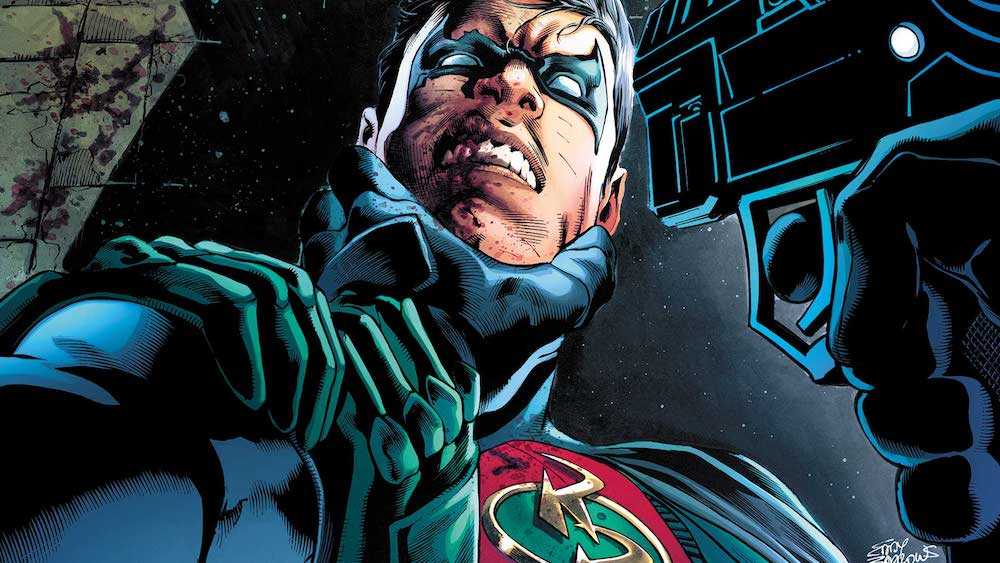
Once upon a time there was a comic that had sharks with machine guns and it’s not even our spotlight title! Batman: Detective Comics #967 earns the honor because Tim Drake is finally reunited with the team he helped build. Still, Kamandi Challenge #10 has those sharks!
Around the rest of the DCU, there is much gloom and doom, making it harder for the DC House of Horror #1 to stand apart from the crowd. Plus, Dick and Babs’s team-up continues in Batgirl #16; Ryan Choi formally becomes a hero in Justice League of Ameria #17; Bernard Chang has a standout issue of Batman Beyond #13; and Ruff and Reddy #1 might be the weirdest topical comic ever.
This, plus reviews of all the other DC Comics.
WARNING: MAJOR SPOILERS BELOW.
Spotlight Title: Batman: Detectie Comics #967
Batman: Detective Comics #967 – James Tynion IV, Writer; Alvaro Martinez, Artist; Raul Fernandez, Inker; Tomeu Morey, Jean Francois Beaulieu, Colorist
Ray – 9.5/10
Corrina: Tim Returns To His Team
Ray: After a little over a year, it’s the moment everyone’s been waiting for – the return of Tim Drake to the Bat-family. I just don’t think anyone was expecting there to be two of them. The issue opens with Bruce, having clearly not slept in days, obsessing over the footage of Tim’s “Death” and trying to figure out what he got wrong. I like that Bruce has gone meta, understanding that the Robins will undeniably come back when they die and developing a system to figure out how. But Mr. Oz got past it, and Bruce has found no clues – until Tim’s distress beacon activates in Gotham City. He managed to escape after being abandoned by Titans of Tomorrow Tim, and what ensues is a well-earned emotional coda as Bruce makes his way to the hospital and reunites with his adopted son. I have to say, my favorite part of Rebirth is that Bruce has been allowed to be a dad again.
But it’s not all sunshine and roses. While Tim is getting tacklehugged by Cass, reuniting with the rest of the Belfry, and briefing them on what he knows (although he still doesn’t know why Steph isn’t there), evil future Tim is skulking around Gotham, stalking Steph, planning his assault on Batwoman, and meeting with Alfred to try to get his mind around what he needs to do to secure his future. This future Tim could have easily been a one-dimensional villain, but Tynion knows Tim Drake well enough that you can see shades of the same character, albeint one who has sold his soul many times over. The non-Belfry ex-Robins showing up to confront Future Tim is great, and the ending of the issue has the return of a major DCU villain courtesy of Future Tim’s plan – one that’s been misused many times, but if Tynion wants to make a go of using him again, I have no doubt there’s a reason. He hasn’t hit a false note in this arc yet.
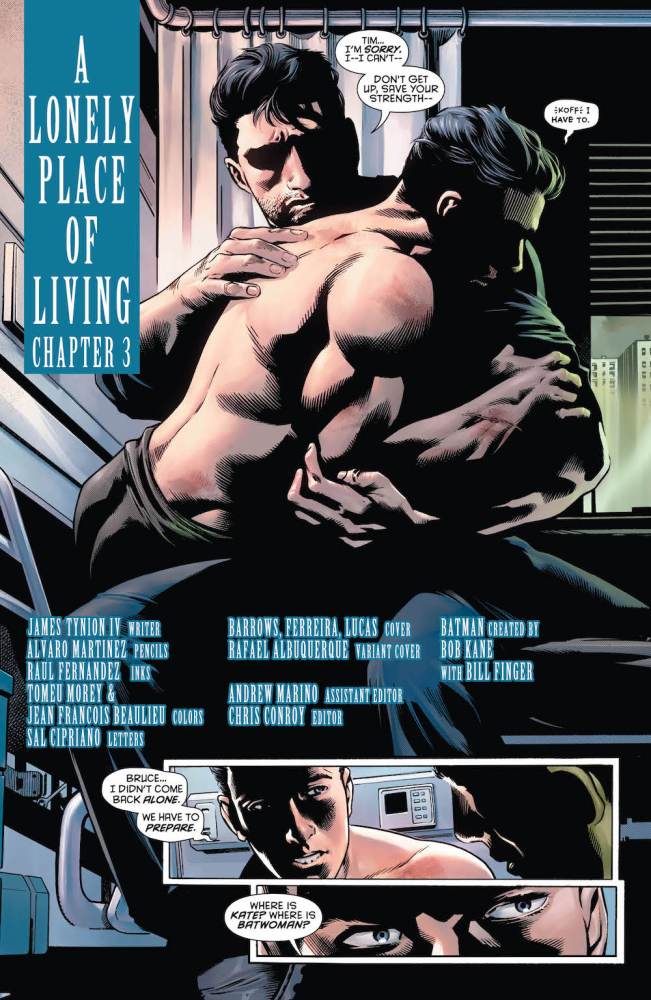
Corrina: It’s certainly the moment Tim Drake fans have been waiting for, as he makes it home, though so does adult evil/warped Tim. (No, not even this fine story is immune to dark or evil twisted horror versions of our heroes that populate the current crop of DC Comics.) There is a great line of dialogue about “the zombie” (Tim) giving them instructions about what’s to come that cracked me up, and some fine banter about the name of the team, and the reunions are heartwarming, except it is getting ridiculous that no one seems to be able to tell Stephanie that Tim is alive. You’re the Bat-crew, give the kid a call, okay, and enough with the forced separation.
I’m enjoying about 90 percent of Tim’s return though I’ve quibbled with some choices here and there. But I’ll reserve judgment on the villain. He’s always seemed ridiculous to me but I’m in the minority there.
Very Good Issues: Ratings 8-9
The Kamandi Challenge #10 – Greg Pak, Writer; Shane Davis, Penciller; Michelle Delecki, Inker; Hi-Fi, Colorist
Ray – 8.5/10
Corrina: Hi Mom!
Ray: After last issue’s dark, bleak, and intimate King/Eastman jam, we’re back to the bright and wacky this issue. Fortunately, Greg Pak is on board for writing duties, and few people do bright and wacky sci-fi action better than him. The issue opens with Kamandi still in the clutches of the mystery robot he tried and failed to defeat last issue, and it seems it’s the robot servant of a mysterious organization that researches and preserves the animal-human hybrid. But when the mysterious Director discovers that he’s a human, all bets are off and they want him alive. When Kamandi sees pictures of his mother, he runs and escapes into the ocean surrounding the base – only to be attacked by mohawked gun-toting mutant sharks. It makes sense in context! Also, those sharks are intelligent (sort of, except when they taste blood) and turn out to be allies.
He makes his way to shore, with the help of the sharks – and let me tell you, Shane Davis is in his element here, drawing epic, crazy battle sequences. This story looks among the best of any of the issues we’ve gotten in this series. He meets up with a group of land-dwelling cat-person revolutionaries with an oddly morbid view of their role in the world, and launches a final assault on the Commander’s tower. Not everyone makes it, but Kamandi makes it in, and finds his mother at last. But there’s still two issues to go, and one big twist left that throws everything we’ve know about the series to now for a loop. This series had some rough spots in the middle, with plots that didn’t fully work, but now it’s hitting its groove as it rockets towards its finale.
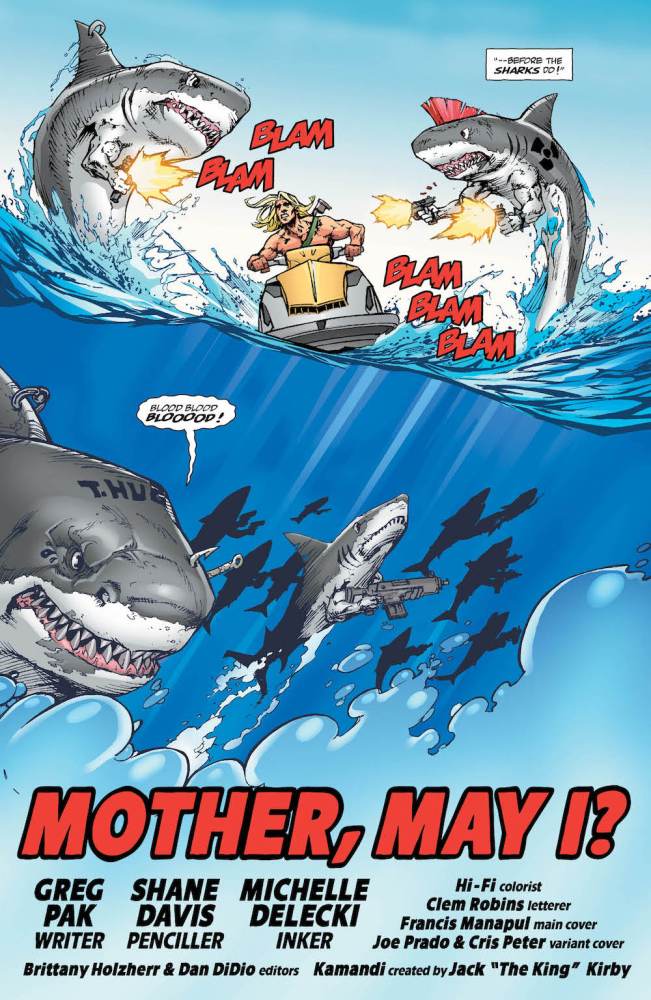
Corrina: So…I guess all those nice aliens from last issue died? Bummer. But at least the action gets going fast in this issue.
I mean, MACHINE GUN TOTING SHARKS. Who doesn’t want to read that? They are sharks. With machine guns. Fighting a war. I love it.
The reveal that Mom is ready to save the world but only by killing all those pesky intelligent animals was expected but, hopefully, she might stick around after whatever the solution is in the next issue? Because I could go for that, rather than have Kamandi wander again.
Batman Beyond #13 – Bernard Chang, Writer/Artist; Marcelo Maiolo, Colorist
Ray – 8.5/10
Corrina: Beautifully Composed
Ray: After two big arcs in a row to kick off this series, the title’s been letting some guest creators shine before Jurgens jumps back in. Last issue brought the excellent Batgirls Beyond issue, and this one lets regular series artist Bernard Chang take the wheel as writer as well to tell a story that would drive most artists insane and make them yell at their writer – but here he has no one to blame but himself! It’s, on one hand, a fairly straightforward story, but the format is genuinely unique – three parallel tales, told in the format of each page getting a few panels of each story. Three locations and timelines, three distinct stories, one overall narrative. The top of each page is devoted to Terry McGinnis’ main story, as he’s trying to get to his brother Matt’s futuristic sports game, but keeps running into Batman-related obstacles.
First up is Shriek, the famous villain from the Batman Beyond cartoon, but he’s given some surprising layers here. Ditto for the new villain, The Hacker. The middle segment of each page is devoted to Matt, usually relegated to being Terry’s tagalong kid. Here, he gets the chance to shine in what’s essentially a futuristic sports anime, as he overcomes his small size to play smarter and outsmart a bully on the field. The bottom is devoted to the villains of the story, as we get a tale set at the dawn of Brother Eye’s invasion that leads to the creation of the actual main villain of the story. There are a few clever surprises in this issue, but overall the main appeal is letting Chang cut loose with an experimental page layout that delivers a unique reading experience.
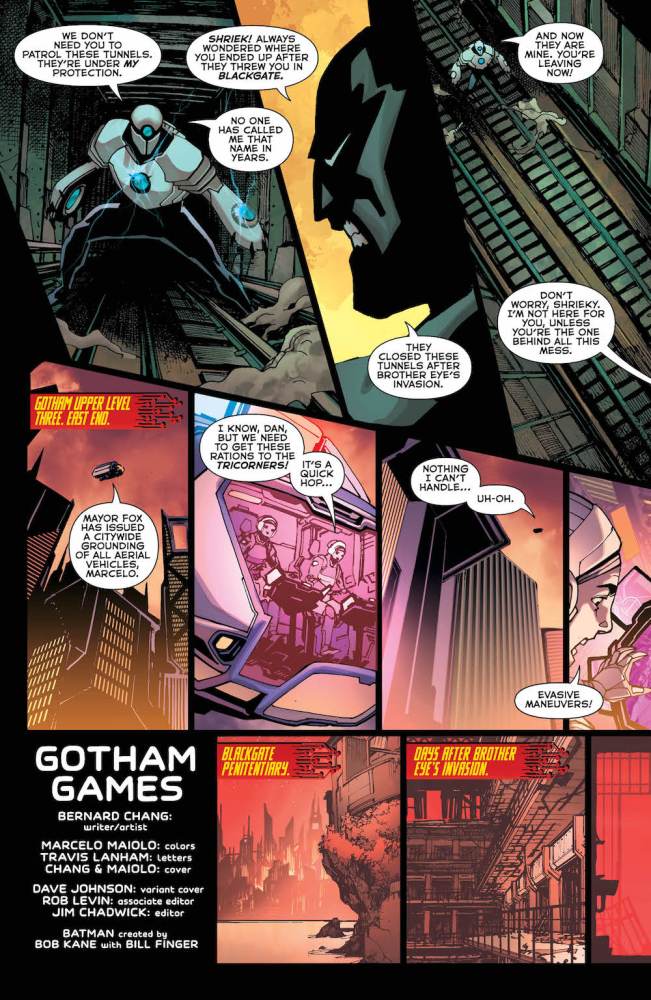
Corrina: Chang clearly needs to be given the writing gig more often because he crafts a unique story in three parts and manages, at points, to make Terry somewhat the bad guy. Not quite, Terry’s just misguided, but I liked his personal arc of simply reacting angrily to the villains and then realizing that, hey, there was a war and people can change.
I loved the coloring in the flashbacks to the villain escapes as well, and a special shout-out to Maiolo for that red/brown/black contrast that made the past seem almost dreamlike. Fans of the television show will enjoy Shriek’s appearance too.
Batman: The Merciless #1 – Peter J. Tomasi, Writer; Francis Manapul, Artist
Ray – 8.5/10
Corrina: Batman as God of War
Ray: Thus far, the four Dark Knights specials have shown us twisted versions of Batman, corrupted by the power of other heroes and turned into monsters. The best of them have taken the core of Batman and shown how his passion for justice led him down the wrong path, while still maintaining his inherent heroic nature. This is one of the best of them, showing how he fell into the thrall of magic and became an evil conquerer. Told by Tomasi and Manapul in non-linear style, parceling out pieces of his origin alongside his brutal siege of the ARGUS HQ, it all started when the Justice League fell in battle against Ares, who was powered-up with a new helmet that made him near-unbeatable. Seeing the opportunity, Batman seized the helmet, defeated Ares – and then, consumed by the power of the helmet, sought to end all war by putting Earth under his boot.
Meanwhile, Tomasi and Manapul turn the focus on the last line of resistance against the Dark Knights, bringing together Steve Trevor, Amanda Waller, Sam Lane, Director Bones, and the lesser-known Father Time and Colonel Jonas in a deep underground bunker. As these military men/women/skeletons plot their next move, the Merciless invades the base, cutting through defenses like butter. Although I didn’t find the various commanders all that interesting, this evil Batman’s narration is among the strongest yet, painting him as a tragic figure with a clear motivation for becoming corrupted – while hiding until the end an incredibly dark secret that marked the start of his path to evil. And Manapul’s art manages to be bright and fantastical while showing off a surprisingly dark edge.

Corrina: Yet another version of Batman corrupted to the soul. Damn, after this is over, I would never trust Batman again if I were the Justice League, right? And that’s only part of my problem with this idea to go extreme horror with the DCU, right down to Batman as God of War deciding to kill Diana as the big reveal. There’s nothing new here, just more bleakness, no new insights in the DCU. The only bright spot is perhaps provided by Steve Trevor’s hopeless optimism in the face of this dark Earth rebellion/rising. I’m not having fun with this event, DC.
The Flash #33 – Joshua Williamson, Writer; Howard Porter, Artist; Hi-Fi, Colorist
Ray – 8/10
Corrina: Dark, Dark, Dark. METAL, Dude.
Ray: The second “Round Robin” crossover of Metal begins, jumping through Flash, Justice League, and Hal Jordan and the Green Lantern Corps over the next month. Like Gotham Resistance, it’s a frantic, relentless action-packed story that fills in some of the blanks that there’s not enough space to cover in the main Metal mini. It feels a bit smoother than Resistance right out of the gate, and throws us right into the action with Flash and Superman teaming up to send Superman into the Dark Multiverse in search of Batman. Flash and Steel are guarding the portal, while Wonder Woman and Doctor Fate head to the Rock of Eternity, Hal and Mr. Terrific travel to the heart of the Thanagarian empire, and Aquaman and Deathstroke swim to the forbidden zone of Atlantis. But before they can reach their destination, they get a panicked distress call from Cyborg.
The Dark Knights are on their way, led by the Batman Who Laughs, and they each find themselves under attack by evil Batmen specifically designed to target them. We’ve met most of them before, with a few exceptions – we still know absolutely nothing about this Devastator, a mutated Doomsday-like Batman, for instance – and this issue does a great job of infusing the story with a sense of dread. Barry’s visit to a post-apocalyptic Central City where the Red Death’s powers have drained people of their life force allows Williamson to get some brief closure on Barry and Iris’ separation, but then we’re thrown right back into the action as the Batman Who Laughs prepares Batcave deathtraps for each member of the League, specifically designed to target them. You have to really like Metal overall and want more of it in order to get into this issue, I think. Fortunately, I do!
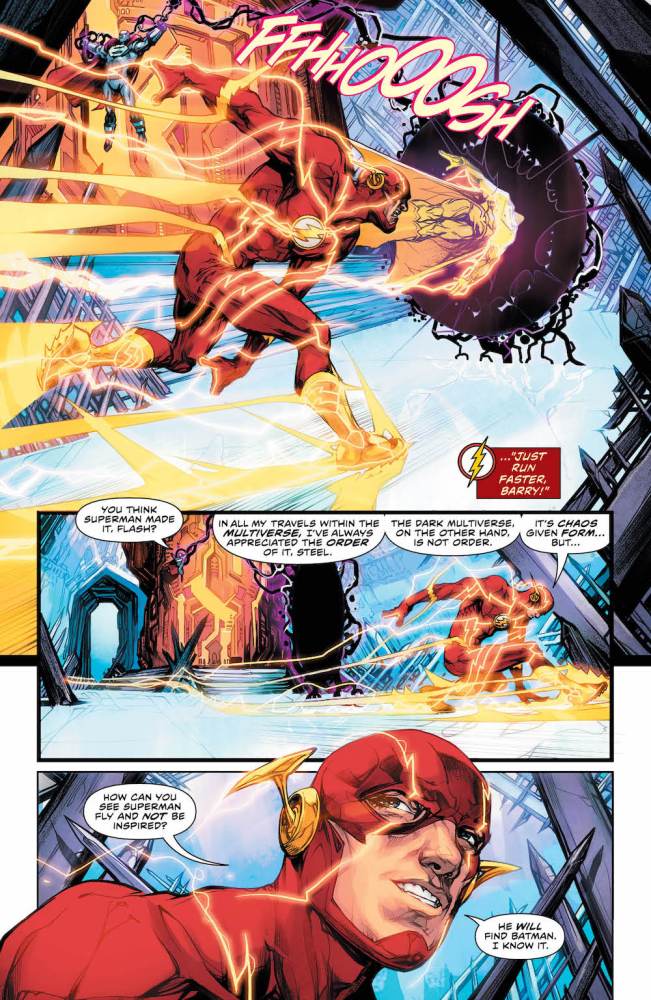
Corrina: Another loss in this whole joyless Metal event, which lacks any semblance of hope. I’m bummed it interrupted my regular Flash comic. And I have no desire to see deathtrap Batcaves specific to each Justice Leaguer. As I said above, damn, if I were a JL member, Batman would be so out after this.
Superman: Action Comics #990 – Dan Jurgens, Writer; Viktor Bogdanovic, Artist; Trevor Scott, Scott Hanna, Inkers; Mike Spicer, Colorist
Ray – 8.5/10
Corrina: Jor-El Offers Paradise
Ray: The penultimate chapter of “The Oz Effect” brings some major developments, as Jor-El’s plan for Superman and his family becomes clear and we learn a lot more about his MO as an adversary. And I have to say, after being skeptical about this story at the start, Jor-El is turning into one of the most fascinating new rogues to enter the DCU in a while. The issue opens with Superman uniting his allies from around the hero community to hold off the wave of attacks and sabotages across the world, stopping one crisis after another from erupting. He even kidnaps the two warring leaders of Logamba and isolates them, destroying their weapons stash and forcing them to negotiate for peace. Meanwhile, though, Jor-El has zeroed in on Superman’s most vulnerable spot – his family. After saving Lois’ life from a bomber last issue, he turns his focus to Jon.
Last issue, we saw a utopia that looked a lot like the Legion – a world where Jor-El wants to take Jon where he can use his powers freely. It looked like the Legion a lot at first, but now I’m not so sure. It features a lot more alien creatures, utopian architecture – could it be Jor-El’s vision of a new Krypton? Either way, Jon is understandably enchanted by it and is very receptive to Jor-El’s argument that Earth is too brutal, too unkind to deserve them. He also seems to hint that he wants to evacuate them before something comes, something that will end this realm. Doctor Manhattan, I presume? By the time Lois summons Superman and they go to rescue Jon, Jon is fully on board with Jor-El’s plan – while Superman has just stopped his father’s cultists from destroying Metropolis. All this sets up what looks like a fantastic showdown next issue as three generations of fathers and sons battle for the future of their line. This could have gone so bad, but Jurgens knows Superman, and he’s delivering.

Corrina: Jor-El’s plan: Look, Earthlings are evil, I’ll prove it by manipulating them. Oh, and, say, I can offer paradise if you’ll just let everyone else die. That’s not much of a sales pitch, there, Jor-El. The conflict between Superman and Jon also feels forced because you’d expect Jon, after what he went through with the evil aliens, to be wary of any strangers attempting to sell him the stuff that Jor-El is selling.
And, once again, Lois is sidelined and all she can do is call for help. Apparently, one has to be a pre-teen boy to get any attention in the Superman family stories.
Teen Titans #13 – Benjamin Percy, Writer; Khoi Pham, Penciller; Trevor Scott, Inker; Jim Charalampidis, Colorist
Ray – 8/10
Corrina: Yay, Wally’s Back
Ray: Damian’s tenure as the worst Teen Titans leader ever doesn’t seem to be getting any better, as this issue he continues to alienate his team, and no one’s even really sure if he’s the leader anymore. Starfire kind of took charge last arc (which makes sense, given that she’s actually an adult hanging around with a bunch of teenagers for some reason?), but Damian still thinks he’s in charge and opens the issue by beating up virtual avatars of his own team. After a fight with the team over his decision to fire Kid Flash, he tells them to go after him themselves. Wally, who is busy in school (when he’s not moonlighting for a supervillain, of course), is happy to reunite with Raven, who he had some romantic flirtations with, but makes it clear that he’s not going back to the team hat in hand. If they want him back, Damian needs to apologize. Good luck with that.
Speaking of Damian, his part this issue is a lot of fun, because it co-stars Emiko Queen, probably Percy’s most likable and entertaining character across his two books. She has a lot of overt similarities to Damian, but she’s differentiated herself. She seems interested in learning how to be a normal teenager, but at the same time she’s also much more impulsive and less self-trained than Damian. So while they’re both small assassins with an evil parent, they don’t sync up. Damian sweeping in like God’s gift to invite Emiko to join the team and her slapping him down was fantastic. I was a bit surprised to see classic Green Arrow villain Onomatopoeia show up, creating mass chaos, but he works for the story although he’s much less intimidating than usual. I’m still not sure this group works as a team, but Percy’s in his element this issue with great dialogue.

Corrina: I dislike Damian the snotty brat most when no one is calling him on his mess or, when the story point of view seems to assume he’s correct. Therefore, I enjoyed the heck out of Emiko putting him in his place, pointing out that if his team is so solid, why is he there alone? And that insight is a true one, even if she does need his help with the tidal wave. What can Damian do with a tidal wave? Guess we’ll find out. I hope it’s Wally that solves the problem.
Meanwhile, the other Titans act like more of a team than ever with their visit to Wally, and it’s nice to seem them, at least, act like friends. This is probably the most enjoyable issue of Titans I’ve read in this run.
Justice League of America #17 – Steve Orlando, Writer; Ivan Reis, Penciller; Julio Ferreira, Oclair Albert, Inkers; Marcelo Maiolo, Colorist
Ray – 8/10
Corrina: Not Quite Ray Vs. Ryan But Excellent Anyway
Ray: It’s the final issue of “Panic in the Microverse”. With Aron Aut fully exposed as the villain and both Atoms of Earth united to stop him, it opens looking like all is lost. Aut, more powerful than he’s ever been, uses Palmer’s tech to shrink the Justice League into oblivion – despite the imperfect beta tech not being safe for human survival. Tiny Lobo does make me laugh, though. Aut is about to launch a machine that will shatter the Microverse beyond repair, and Palmer is out of ideas – but Ryan isn’t. Thinking outside the box, he comes up with an idea that involves him getting smaller than anyone’s ever managed. Grabbing onto Aut and shrinking them both into the world beyond the Microverse, they both wind up in what looks like an endless entropy as Ryan prepares to sacrifice himself to save the entire universe.
Reis manages to do both great character work and great scenery, capturing the emptiness of the microverse. Ryan’s sacrifice is “foiled” when Caitlin manages to use Ray’s tech to grab him right in the nick of time before the explosion that seemingly takes out Aut (his fate is oddly ambiguous). It’s a little odd that the main event of the issue is over by just past the halfway point, leaving the rest of the issue for an epilogue. Moz-Ga returns from his exile to help heal his world, Ray and Preon reunite, and Ray – wanting to stay behind in the Microverse to continue helping and stay with his new love – officially passes the Atom name and all of the tech that comes with it on to Ryan. Overall, it’s a great coming-of-age story for a legacy hero coming into his own, with some great sci-fi concepts. Next up, Orlando turns his focus on one of the JLA’s deadliest villains, Prometheus, in a story that promises a sequel to elements from his Midnighter run.

Corrina: I love that Ryan will continue as the official Atom of the DC Universe. I hope it sticks because he’s a terrific charater, earnest, smart and empathetic, and still learning, all of which is great for character development, more so than an experienced hero mourning over his mistakes, as Ray would be.
Together, the Atoms save the Microverse and, hopefully, part of the world, and Ray receives a happy ending too. All in all, a fine arc, if a little bogged down with the flashbacks in the middle.
Blue Beetle #14 – Christopher Sebela, Writer; Scott Kolins, Artist; Romulo Fajardo Jr., Colorist
Ray – 8/10
Corrina: Decent Start
Ray: This is the first title to be helmed solo by a graduate of the DC Writers Workshop, and Chris Sebela has definitely earned the shot to close out this series given his excellent scripting work on Detective Comics in the last few months. And right out of the gate, it’s a massive change of pace and improvement from the Giffen/DeMatteis run. Gone are the continuity-heavy sci-fi action and callbacks to past Giffen series. Instead, Sebela draws on the Rogers run, which was as much about teen drama and growing up as it was about the alien threats. And there are alien threats here – in the form of a giant geometric space ship that incinerates a pair of unfortunate UFO chasers in the opening segment. But whatever they are, they’re more of a plot device to drive Jaime’s story in this issue.
The real crux of this issue is Jaime experiencing the same fear of change that all teenagers his age do. He’s one week away from entering his senior year, and has spent most of his summer hanging out with his girlfriend Naomi and avoiding thinking about what comes next. Then Naomi wants to know about his post-high school plans, and Ted Kord wants to offer him a job. Taking the bonus he got from Ted as a temptation, he decides to take a road trip with Naomi, Paco, and Brenda. I had some quibbles with the interaction of the cast, although that’s all things that have been left over from earlier in the series. Naomi’s a bit too much of a blank slate (and her not knowing Jaime’s secret is a cliche) and Paco and Brenda fight way too much, but overall, this is probably the best issue of the series. Sebela’s going to be writing much bigger titles for DC after this one wraps, I predict.
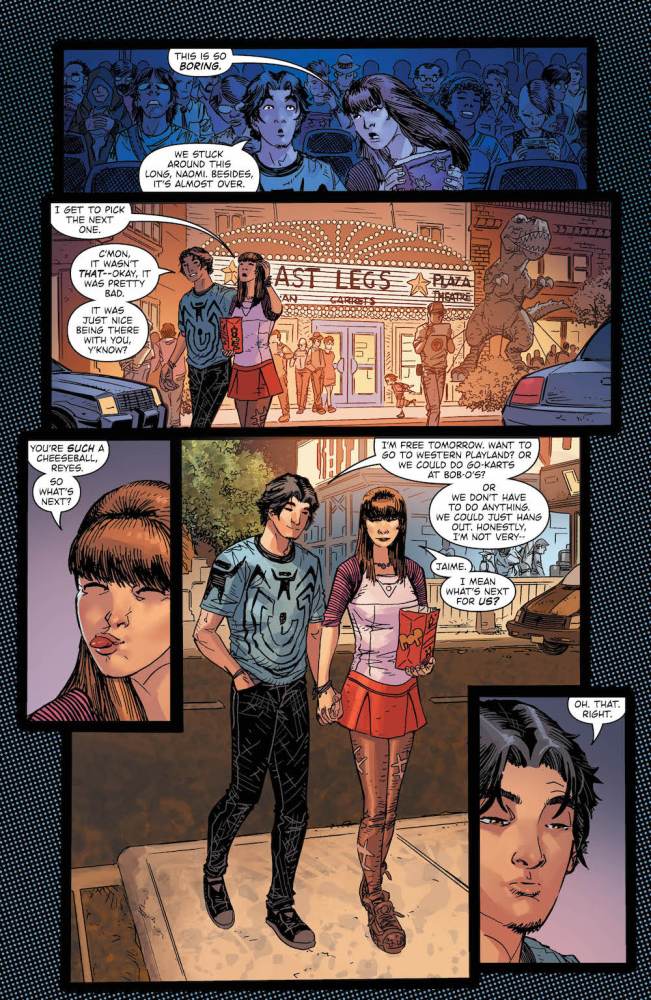
Corrina: I agree with Ray. This isn’t a perfect issue but it’s certainly the best of the entire series, lacking any of the weird manic dialogue and the characters shoehorned in from the failed title that marked the previous creative team’s work. This focuses on Jaime and his friends and it slows down enough so we finally get a true sense of all their personalities. It’s too bad this is not the first issue of the series, rather than one of the last.
Batgirl #16 – Hope Larson, Writer; Chris Wildgoose, Penciller; Jose Marzan Jr., Andy Owens, Inkers; Mat Lopes, Colorist
Ray – 8/10
Corrina: The Truth Comes Out
Ray: The penultimate chapter of “Summer of Lies” finally reveals the truth behind the Red Queen and unravels the story of Barbara’s high school friend Ainsley with a shocking reveal. Larson’s ear for dialogue is this issue’s biggest strength, right from the start in a flashback segment where Batgirl and Robin break into a Purotech base and interrogate a pair of hipster goons. These guys are basically the worst mooks ever, and it ends with them protesting that they don’t want to fight and sitting down for a nice conversation. However, the reveal about the drug that Ainsley is working on – a nanovirus that functions as a non-narcotic high – is kind of a fascinating concept. However, when they spy on Ainsley’s secret rendezvous, it’s not a supervillain meeting, but a recovery meeting.
If there’s one element in this series that feels a bit forced, it’s the romance between Batgirl and Robin. The lead-up to their first kiss feels rather abrupt, and while they make great partners, their snarky banter doesn’t quite feel like romantic connection to me. It feels like Larson is writing a great Batgirl/Nightwing team-up story, but that’s it. In the present day, they head to the recovery center where Ainsley stayed, fight a bunch of nano-possessed orderlies, and eventually learn the shocking truth behind Ainsley’s disappearance. I will say, I pretty much called the identity of the Red Queen the second the character was mentioned this issue – it’s textbook to casually mention a new suspect before the big reveal. But overall, this arc has delivered some satisfying suspense and great character work.

Corrina: My favorite chapter of this Dick/Babs team-up, as it’s paced nicely, interspersing the flashbacks with the current story, and finally gives us the reveal about the Red Queen. Plus, it’s without either hero basically shrugging off failing to prevent murder as “eh, we tried.”
The nanovirus is an interesting concept and I love the way Barb hacked it this issue to save everyone, as well as enjoying how the villain faked them out . This arc is dripping with the regrets associated with growing up, especially with the parallel stories of young Dick, Babs and Ainsley, and with the present-day fallout from them.
Scooby-Doo Team-Up #31 – Sholly Fisch, Writer; Dario Brizuela, Artist; Franco Riesco, Colorist
Ray – 8/10
Ray: Another enjoyable outing for the Mystery Machine gang, as they take on one of the more offbeat corners of the DCU. This time, it’s the Atom and the Microverse, in a perfectly timed tie-in to the current Justice League of America arc. The issue opens with the gang helping to foil the Bug-Eyed Bandit, one of Atom’s old-school villains, before he recruits them to shrink alongside him and investigate a mysterious microscopic event – a “ghost head” that appears on the way to the Microverse, projecting an ominous face to anyone who lives in that realm. They shrink further, and wind up in the Microverse – where they immediately come under attack by armored knights.
They soon get mistaken for supporters of Archaea, a rebel against the ruthless Wizard King. The Wizard King is supposedly a powerful sorcerer who rules the kingdom with an iron fist, using his magic to project his face across the realm. Their attempt to foil him leads them to be captured along with Archaea, and in prison Daphne starts to figure out that the Wizard King isn’t what he appears to be. This leads to a wildly entertaining showdown of magic against magic – or rather, light show vs. shrinking belt. It’s one of the most clever installments of this series, and it’s also surprisingly the first part of a two-part story, as another small character shows up at the end, from the Hanna-Barbera stable.

Good Comics: Ratings 7-8
The Hellblazer #15 – Tim Seeley, Writer; Jesus Merino, Artist; Carrie Strachan, Colorist
Ray – 7.5/10
Corrina: Don’t Ever Get Into a Relationship With Constantine
Ray: Tim Seeley’s brief run on Hellblazer wraps up, before Vertigo veteran Richard Kadrey jumps on for the next arc. Seeley is a veteran horror writer, and it shows in this arc, which is darker and more grotesque than past Hellblazer stories since he made his return to the DCU. However, this issue veers a little more into DCU territory before coming back home for a typically Constantine downbeat ending. The issue opens with Constantine recapping the story, involving a cursed wine, him being framed for a murder, and his reunion with a former lover. This is right before he jumps into a corpse’s open mouth and descends into hell to pay a visit to a grotesque demon bar. There, he downs some enchanted ale, and enters a surreal battle arena in his mind.
John wakes up in an old club, with his former punk rock band, and proceeds to take a greatest hits tour through his past. Then, he’s tracked down by former allies, starting with Swamp Thing and Zatanna and leading into a showdown with the entire Justice League. He drinks, fends them off, and heads into a bar where he rescues Margaret and tricks the demons behind his misfortune into a circle, where he’s able to effectively banish them without hurting her. At least physically. They head back home, where they have reunion sex – and then Constantine proceeds to say cruel, hurtful things to her and leave her, in what’s obviously an attempt to separate from her before she gets hurt again by connection to him. Constantine is never allowed a happy ending, so this makes sense, but while this arc was a big improvement over the first year, the ending does feel a bit rushed.

Corrina: The trick with Constantine is finding a plot where we care about what happens to him and yet preserves his status as a cynical anti-hero who is not, in any way, shape or form, a good person. This arc started with a murder that we thought John might have committed and quickly morphed into a horror comic, as it fitting for the series. This issue wraps up the plot nicely but, ugh, the portal to the villains being the dead guy’s chest is not an image I’d care to revisit.
Solid first arc and the final scenes with John and Margaret are a good encapsulation of why getting involved with John is never a good idea.
Gotham City Garage #2 – Jackson Lanzing, Collin Kelly, Writers; Lynne Yoshii, Penciller; Jose Marzan Jr., Livesay, Don Ho, Richard Friend, Inkers; Kelly Fitzpatrick, Colorist
Ray – 7.5/10
Corrina: Barda Trains Supergirls
Ray: Second issue in, this new post-apocalyptic AU improves a good deal by pulling away from the Blade Runner-inspired techno-dystopia that Kara Gordon grew up in, and focusing more on the world of the Gotham City Garage biker gang. The group of heroes making up this wilderness gang of anti-heroes finally starts getting a bit of definition, starting with Big Barda, who narrates the issue. Her story makes very clear that she’s still a product of Apokalips, and her abuse at Granny’s hands is described in graphic (maybe a bit over the top) detail. It still, however, lacks any of the horror and pure impact we got from King’s take on the same characters in Mister Miracle. Kara, meanwhile, is a slightly overbearing ray of light in a dark world, and Wonder Woman is little more than a myth.
The first half of the issue is mainly setting the tone, as Kara settles into life in the garage, but things pick up in a big way in the second half. Kara goes out on her first supply run with the gang, and they encounter the brutal Red Hood MC. The comparisons to Mad Max: Fury Road are unmistakable here, between the desert landscape and the mutated freaks of the rival biker gang. Still, the visuals here can be stunning, from the daring bike moves Kara pulls off to the monstrous debut of Clayface as part of the landscape. There’s potential here, but the series still suffers by comparison to its rival all-female DC AU, feeling like a sketch of a world compared to Bombshells‘ distinct vision. But the jump in quality with the second issue makes me think it can build from here.
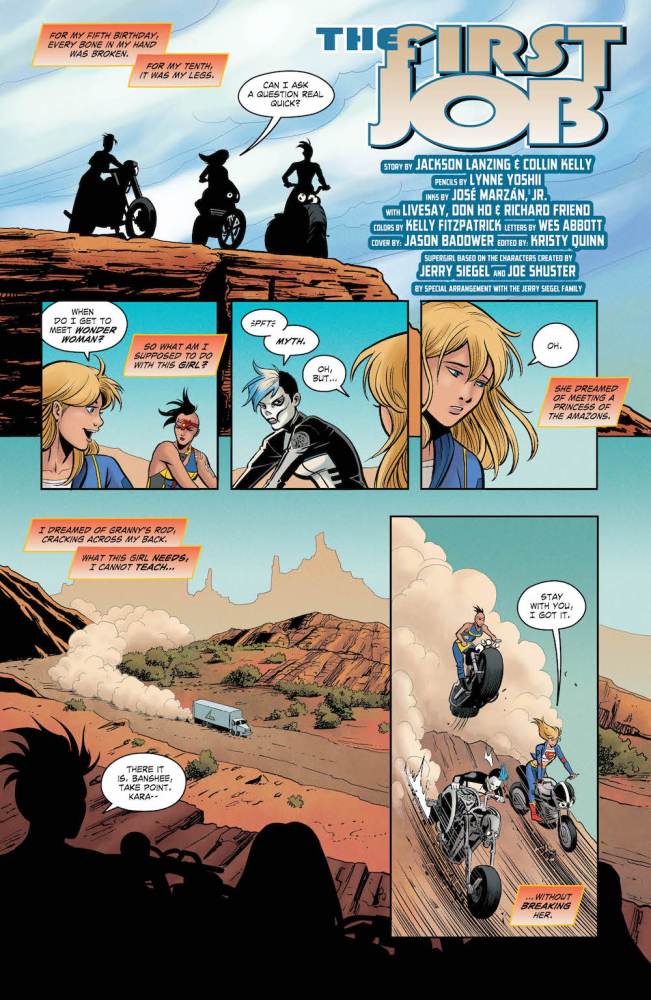
Corrina: After the setup of the first issue, it is good to get down to the action and the story benefits a great deal from switching point of view to Big Barda, who gives us insight into what it takes to survive in this world. Of course, she doesn’t know the power that Supergirl has at her disposal but she can’t afford to trust an unknown, not if she wants to keep her crew alive.
This is Clayface’s second appearance as a monster inhabiting the landscape and it was effective here, though it did serve to remind me of Bombshells and, Ray’s right, this series is not that one’s equal in quality as yet. But it holds promise. (Note: If Barda has the mega-rod, how come she can’t fly?)
The Ruff and Reddy Show #1 – Howard Chaykin, Writer; Mac Rey, Artist
Ray – 7/10
Corrina: I Kinda See Where It’s Going
Ray: You ever read a comic that you’re genuinely puzzled by how it even got greenlit? And you’re even more puzzled by how it was halfway good? That’s this comic. Spinning out of Chaykin’s fairly awful Ruff and Reddy backup from the DC/Hanna-Barbera specials, it thankfully drops the “washed up comedians assaulting the people who took their place” plot which could barely cover that backup. Instead, this comic is essentially a full-length, played straight version of the Simpsons “Behind the Laughter” episode, exposing the tragic history of cartoon characters. Here, Ruff and Reddy are professional actors in a world where humans and “celimates” or animated characters live side by side, with the treatment of celimates being a legitimate civil rights issue in the 1950s and 1960s. Ruff and Reddy are television stars, convincing everyone they’re best friends – but they actually hate each other.
When some deaf kids read their lips and broadcast their whispered insults at a parade to the world, their show tanks in the ratings and they’re both fired. Ruff, desperate to keep his career going, takes any job he can and bounces from failed broadway gig to TV procedural, while Reddy fades out of the spotlight and eventually winds up as a Wal-Mart greeter. It’s all handled with a surprising level of pathos, and the slightly surreal, cartoony art by Mac Rey adds to the strange feel of the comic. The problem is, it’s all too serious by half. Is there even a point to a comic starring old Hanna-Barbera characters if no one’s having fun? As a Hollywood satire, as well as a political satire in some ways, it almost works and is worth reading as a curiosity. But six issues of this? It feels like it could carry two at the most.
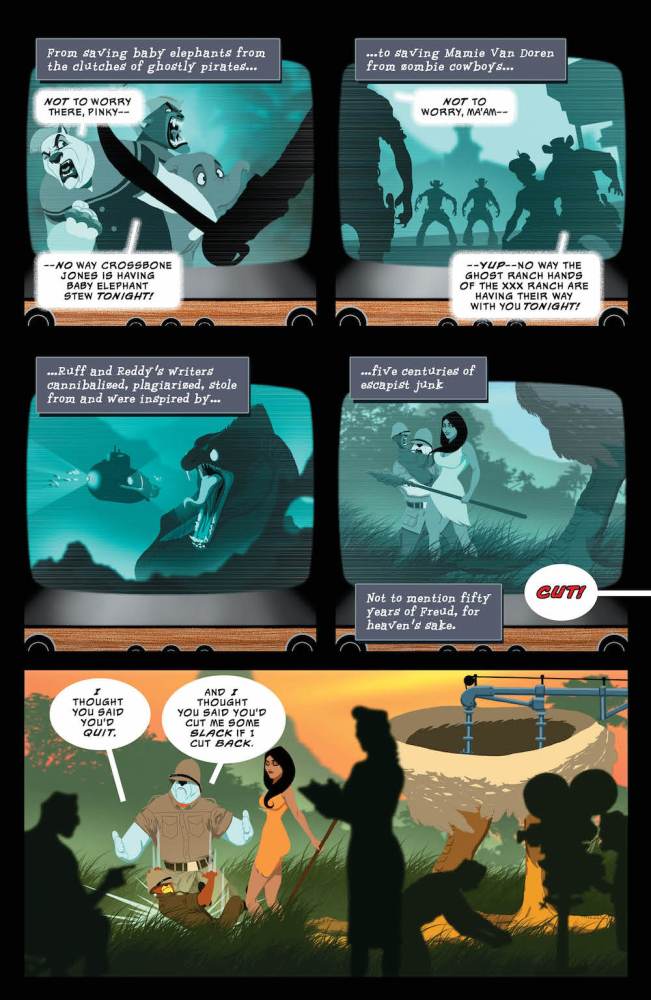
Corrina: I *think* this is some sort of meta-commentary on Hollywood and pop culture and how our ideas have been corrupted from innocence over the years to edgy and angsty, and perhaps now we’re heading to hope again, at least in this universe, with the revival of the original Ruff and Reddy?
At least, that’s my guess as to what’s going on because much of the meta-commentary goes over my head. I suspect if I were more familiar with Hollywood insider history, I might get more than a few of the Easter eggs and yet more of how “stars” are treated and possibly have a better clue about the themes. The creators certainly know what they’re doing. I wish I had enough knowledge to follow them.
Mother Panic #12 – Jody Houser, Jim Krueger, Writers; Shawn Crystal, Artist; Phil Hester, Penciller; Ande Parks, Inker; Jean-Francois Beaulieu, Trish Mulvihill, Colorists
Ray – 7/10
Ray: The first year of Mother Panic wraps up this issue, with the series returning at a later date after the Milk Wars crossover. And while this final issue has some fantastic visuals courtesy of creepy gothic artist Shawn Crystal, it doesn’t quite land in terms of story. As the issue opens, Violet is in the clutches of the psychotic artist villain Gala, after being betrayed by her fellow Gather House alumna Jane. The issue opens with Violet suspended from a monstrous skeletal sculpture, in one of the most gripping visuals of the entire series so far. Crystal’s art reminds me a bit of Kelley Jones in places, although his human figures look less stylized. After a murder and a daring escape, Violet is forced to confront both her arch nemesis and her former friend.
The problem is, twelve issues in, we still know very little about Gala. She’s got ties to Gather House, she’s got an obsession with abstract and bloody art, and she’s perfectly suited to Gotham’s rogues. But she’s still essentially a cipher. This book feels like it keeps the reader at arm’s length, showing us hints of interesting characters, but pulling back at the last minute. The same goes for Violet’s mother, who has some intriguing reveals at the end of the issue, and for Violet herself, who still feels like a sketch of a character. The main story looks great and has a vibe perfect for Halloween, but it lacks a connection. The backup wraps up this issue as well, giving us a connection to Gather House in the reveal, but not enough story to really click as a whole.

Corrina: The stories in this series are good but the difficulty I have is that the foundation–that of Violet being trained as an assassin at a school–is not unique enough to carry Violet’s backstory. It’s the same backstory as Cassandra Cain or over in a Vertigo series and was used in the Grayson series, with Helena Bertinelli as headmaster. When the series concentrates on Violet trying to help other victims or trying to bond to the cipher that’s her mother, it works well. When it concentrates on her backstory, such as in this arc, with her guilt about burning the house down to lead her to mistakes, it falters because, as Ray said, the villains who ran Gather House never rise to become three-dimensional. Violet, with her physical and emotional damage, is a compelling character set in a world that doesn’t allow her to stand out as it should.
Hal Jordan and the Green Lantern Corps #31 – Robert Venditti, Writer; Patrick Zircher, Artist; Jason Wright, Colorist
Ray – 7/10
Corrina: More Horror!
Ray: Last issue’s short Earth-based art kicked off as a pseudo-sequel to the Keith Champagne Parallax story in Superman, but then abruptly dovetailed into a Hector Hammond story. Hammond is probably my least favorite character in Green Lantern, so my interest in this story instantly took a nose-dive. However, this issue packs some surprisingly nice character-driven moments that save it. The issue opens with Hammond being captured and experimented on by an army of yellow alien moloids, in service of their evil boss the Master Engineer. Before they can drag him off to steal his brain, however, Hal and Superman burst through the roof. The first half of the issue is mostly the two heroes just batting around ugly yellow aliens, but then Hector is forced to play with their minds.
Hal immediately finds himself in an alternate universe where he’s not Green Lantern, and instead has time to spend with his large extended family – not to mention Carol, who he’s together with in this world. Sure, it’s basically the plot of the Nic Cage film “Family Man”, but Venditti’s writing sells it. It’s all he can do to pull himself out of the illusion and back to reality, where he helps Superman do the same as the Kryptonian struggles with memories of the Kents. Then Hammond ends the threat in a rather violent way, which leads to a slightly awkward conversation between the two heroes. However, the story ends on a strong note, as Hal decides to try to reconcile with Carol – only to get a harsh reminder of his job duties and back away. This isn’t one of the series’ strongest arcs, but Venditti has a good grasp on Hal that keeps it on the winning track overall.
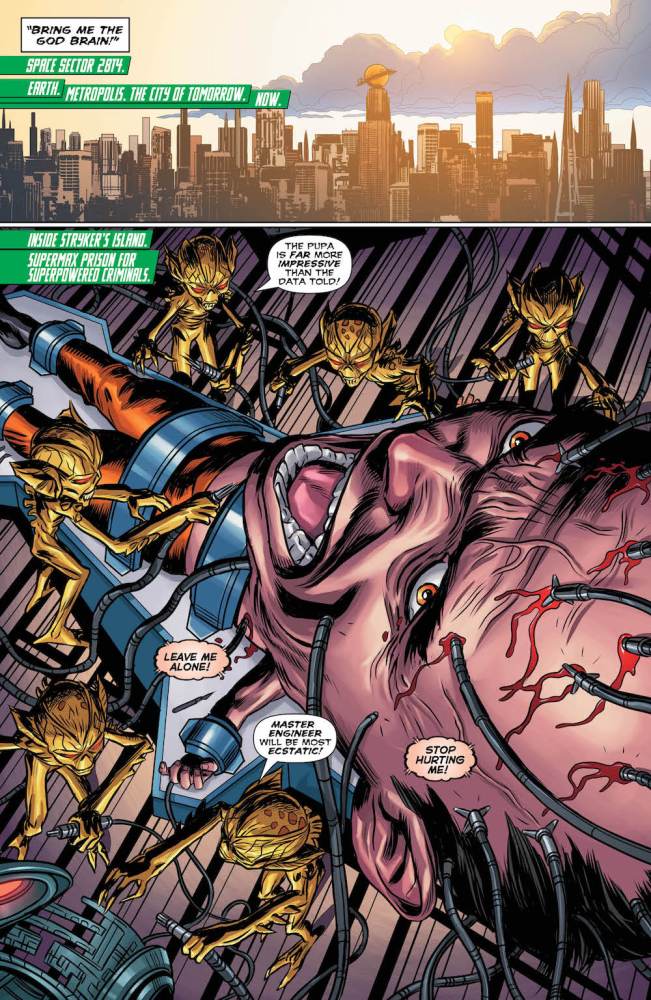
Corrina: Those little weird aliens crawling all over Hector Hammond were freakier than anything in the DC House of Horror issue. I just may have nightmares. It’s an effective sequence with Hal tempted by his dreamworld and overcoming it because even the dream Carol knows what’s what. That Zircher can make the aliens so freaky and yet the fantasy so warm is a tribute to his work.
However, the “oops, can’t tell Carol, there’s a crisis” at the end was more contrived than Spoiler not knowing Tim is back over in ‘Tec. I never like that kind of tease.
Needs Work– Issues Rated 6 and Below
Wonder Woman #33 – James Robinson, Writer; Emanuela Lupacchino, Penciler; Ray McCarthy, Inker; Romulo Fajardo Jr., Colorist
Ray – 6/10
Corrina: Grail is Nash
Ray: Three issues in, it’s very clear that James Robinson’s Wonder Woman run has one glaring problem – it’s not a Wonder Woman run. The first issue was about Hercules. The second did feature Wonder Woman heavily, but it was all about her following one character’s legacy and then chasing after another new character. And this third issue doesn’t feature Wonder Woman at all! Instead, it’s a direct follow-up to the Darkseid War storyline that killed Darkseid and resurrected him as a baby. Now in the custody of Grail, his evil-and-yet-somewhat-hapless daughter, Darkseid needs to feed on the souls of old Gods in order to regain his strength and age up to his proper form. I won’t deny that Baby Darkseid is an amusing concept, but nothing will top that one panel of Metal.
The issue operates in a non-linear fashion, flashing back to the early days when Grail was on the run with her baby-dad, trying to figure out how to restore him, to the present day when Darkseid is a preteen eating the souls his daughter procures for him. Thing is, the “Kid Darkseid” story could have been a lot more amusing if he actually was acting like a petulant child-god, but instead he already sounds like Darkseid, imperiously threatening people. Grail, surprisingly, is a bit compelling here, and there’s still a lot to her story to be told. But none of this justifies the fact that the big Wonder Woman run launching in the wake of one of the most successful superhero movies of all time has barely featured Wonder Woman. It’s not a terrible comic, but compared to Rucka’s defining work, it’s a major disappointment.

Corrina: I was going to ding this story for not having Wonder Woman in it as all for being, well, sexist and ill-advised (the second is still true) and then I realized there’s a bigger issue than that: Robinson is basing Grail’s arc and attempt to please her father on his original creation of Nash from his classic (and excellent) Starman run. In a spotlight issue of that series, Nash was a girl who could never please her father and went on a killing spree to prove she was badass and to get closer to him. Here, Grail goes on a killing spree to appease the father figure she needs to approve of her, with the switch being Darkseid is a baby and is slightly more approving of Grail than Mist was of Nash.
I hope this is not leading to Grail attempting to rape Jason, as Nash did with Jack Knight.
But, in any case, it’s an inferior story to the original. I find the baby Darkseid thing ridiculous, and it’s just one death after another, leading us up to Grail spotting Jason, which is where we ended last issue.
So, Robinson isn’t being sexist by leaving the main character out of this story chapter. But he is repeating himself. And he’s working with a concept much less compelling than the complicated family dynamics seen in Starman.
DC House of Horror #1 – Keith Giffen, Plot; Edward Lee, Mary SanGiovanni, Bryan Smith, Nick Cutter, Brian Keene, Ronald Malfi, Wrath James White, Weston Ochse, Writers; Howard Porter, Bilquis Evely, Kyle Baker, Rags Morales, Scott Kolins, Dale Eaglesham, Tom Raney, Howard Chaykin; Hi-Fi, Romulo Fajardo Jr., Mat Lopes, Jordan Boyd, Gina Going-Raney, Lovern Kindzierski, Wil Quintana, Colorists
Ray – 5/10
Corrina: The Context Is the Problem
Ray: DC’s anthologies have been on an incredible hot streak lately, bringing together top talent and the best characters in the business, often for stories that have real impact and emotional weight. One story – the introduction of Ace the Bat-Hound – even won an Eisner award. So I had high hopes for this Halloween special, which boasts eight tales with plots created by Keith Giffen, a host of top artists, and the DC debut of acclaimed horror author Brian Keene. Unfortunately, the execution of these creepy tales doesn’t live up to the potential. These stories aren’t in continuity at all – instead telling twisted tales of how DC icons could go horribly wrong. Unfortunately, while a few have intriguing ideas, the majority are just oddly ugly.
The issue opens on a bad note with Edward Lee and Howard Porter’s Superman tale, which reinvents Superman’s arrival on Earth as an alien horror story. Instead of an innocent baby, Superman is an out-of-control alien monster, barely looking human at all, whose powers are fully formed and whose rampage leads to the graphic death of Martha Kent. Mary SanGiovani and Bilquis Evely’s Wonder Woman story has some more redeeming qualities, reinventing Wonder Woman as a ruthless Amazon spirit who is summoned by some girls in a “Bloody Mary”-like ritual and exacts a brutal revenge on an abusive father. “Crazy For You”, a Harley Quinn story by Bryan Hill and Brian Keene with unique art by Kyle Baker, reinvents Harley as a ghost of an Arkham inmate who haunts a former guard and drives him to horrible actions. It looks great, and has a creepy noir vibe which makes it the strongest story yet. Unfortunately, “Last Laugh”, by Nick Cutter and Rags Morales, which explores a universe where Joker and Batman are both fragments of Bruce Wayne’s fractured mind, falls back on the tired “Batman is crazy” trope and offers nothing new.
The best story of the issue is probably Brian Keene and Scott Kolins’ “Brightest Day”, a high-intensity take on a zombie takeover of the Justice League watchtower. We’ve seen these tropes before, but watching Green Lantern and Flash battle against a fast-moving plague that turns friend against friend has some really compelling moments. “Stray Arrow” by Ronald Malfi and Dale Eaglesham reinvents Green Arrow as a psychotic vigilante serial killer who kidnaps Black Canary “for her own good”. It’s fairly cringey for most of the story, but Dinah’s revenge on her kidnapper redeems it a bit. “Unmasked” by Wrath James White and Tom Raney is the most confused story of the issue, combining Kaiju invasion, evacuation thriller, and graphic serial killer drama into a Two-Face story that really doesn’t work. The final story, “The Possession of Billy Batson”, by Weston Ochse and Howard Chaykin, turns Billy Batson into a teenage punk and the power of Shazam into a demonic curse. The idea has potential, but it ends right when the real story is about to begin. There’s a few interesting ideas in this issue, but unfortunately very few of these ten-page stories fully stick the landing.

Corrina: Keene and Kolin’s visuals in “Brightest Day” are haunting–the image of zombie Flash going splat against the wall will stick with me for a long time, as will Lee and Porter’s concept of a murderously unhinged super-baby in the opening story. However, despite the incredible work turned in by all the artists, this overall concept doesn’t work. It’s not the fault of the creators, but the timing.
The problem is that the DC universe itself is a horror universe right now and so this … feel like regular DC tales, rather than any kind of horror comic, and they basically get lumped in my brain with all the other messes going on at the moment. We have seven warped nightmare versions of Batman running around, we already have seen zombie versions of the rest of the Justice League, and even an arc with the Superman Family turned into alien horror. So while this anthology is good classic horror, it pales in comparison to what DC has made of its’ own universe lately. (Which is a sad commentary on the regular DCU, alas.)
However, if you’re looking for a DC Horror comic to read as a single issue and you’re not reading the other stuff, this may be the comic you’re looking for.
Suicide Squad #28 – Rob Williams, Writer; Eleonora Carlini, Wilfredo Torres, Artists; Adriano Lucas, Colorist
Ray – 5/10
Ray: Although this new arc features some intriguing plot elements, it’s hamstrung from the start by the fact that the plotting and characterization is essentially in a holding pattern. The core team is still split between two missions, one in a space station meeting the past Suicide Squad, while the other is in the desert battling undead robots. Rick Flagg Sr., the leader of the time-displaced Squad, at first seems like a mostly benevolent figure, but he soon shows off some sinister traits – including the willingness to hack the brain bombs of the Squad and prime them to explode in case they’re hesitant to go along with his secret plans.
The problem is…well, what actually is the threat they’re facing? It’s apparently some kaiju that the past team has locked up in the base all these years, and now it’s threatening to break loose. But there’s no sense of urgency, there’s no real drama. All it is is characters wandering around the base, arguing, dealing with personal demons (like Katana and her sword), not to mention more hashing out of the impossibly boring Harley-loves-Rick-Flag subplot. Harley has close to ten love interests, and this is undeniably the least interesting of them. The segments in the desert at least provide some compelling visuals, and Amanda showing up with a BFG entertained me. The brief backup, featuring King Faraday, is probably the best part of the issue, but the series as a whole lacks any compelling hook.

Corrina: Everything I like about this comic is because of callbacks to DC: The New Frontier. That’s not good because it tells me there is not much in the present-day story to attract me. The King Faraday story interested me too and for the same reason.
Nightwing: The New Order #3 – Kyle Higgins, Writer; Trevor McCarthy, Artist; Dean White, Colorist
Ray – 6/10
Corrina: Nightwing Goes Back to Heroing
Ray: The concept of this series could have gone horribly wrong from the start, because the idea of Dick Grayson as enforcer of a ruthless anti-superhero regime is on its face absurd. However, Kyle Higgins saved it somewhat by keeping Dick as a deeply flawed but still inherently decent man who sold his soul to the devil for the greater good. The bigger question is, why would everyone else go along with this regime? And that’s the question that unravels this third issue, as we get a larger picture of how this world operates. At the end of last issue, Alfred was shot by Crusaders and Dick and his metahuman son were arrested. Now, Dick is in police custody, and Kate Kane – the organization’s Pentagon liaison – is trying to keep the situation from escalating. It doesn’t go well, when Dick escapes, wounds his guard, and goes on the run.
From there, the issue follows Dick as he tears through what’s left of the DCU, seeking help from friends and fighting new enemies. His first stop is Tim Drake, who is now retired and lives a quiet life with his family in the suburbs (no wife seen, but one of the kids is a dead ringer for a younger version of a certain fan-favorite blonde heroine and shares her color scheme). Although Tim helps Dick, he’s also still in favor of the Crusader program. So is Kate, who seems to have gone full-on into a militaristic worldview that’s a common flaw when writing military characters. But John Stewart, Lantern ring and all, serving as an enforcer for the US government? That doesn’t track at all. Starfire and Wally showing up at the end bodes well if they’re freedom fighters, but overall this title depicts a DC Universe that lacks much internal logic.
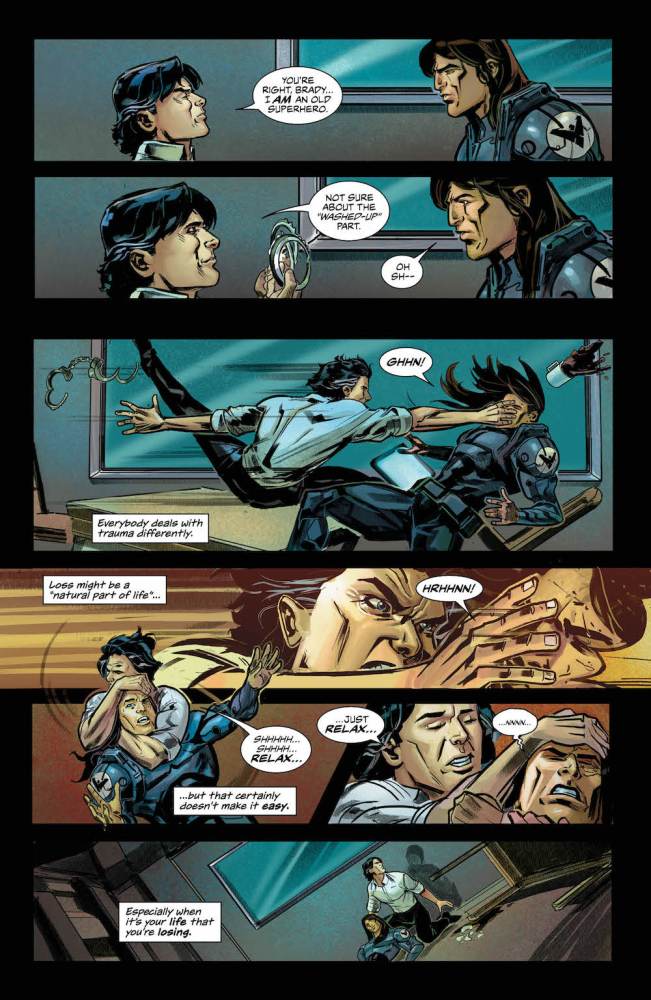
Corrina: The concept is not one I liked but I still want more consistent with the world-building. If what Dick did with taking away meta-powers was so valuable, then why was he so quick to turn on the government, even if it’s his son? Put it another way: if he’s retained that decency, then why hasn’t he been concerned about the other metas being taken into custody, even the children? He seemed happy and willing to ignore that and that’s not Dick Grayson. I can maybe buy him taking away meta powers in the heat of battle to save lives and thinking “the world would be better without them,” but, then again, as the “War of Jokes and Riddles” showed us, the carnage normal humans can create can be equal to the carnage created by meta-humans. Which Dick would know, so the concept falls apart again.
As does Dick accepting a role as a government agent and being in favor of Starfire being controlled. (Which is hinted at.) She’s not meta, she’s an alien and that’s a different thing. Plus, how does all this work? What about magic users like Constantine who are basically human? What about the threats to the world from mystical/demon creatures that might not be able to be controlled? Or Swamp Thing’s abilities, tied to the Earth itself?
I can’t enjoy the series because it’s based on very shaky ground.
Disclaimer: GeekDad received these comics for review purposes.




